Class 10 Science Chapter 10 Previous Year Questions - The Human Eye and the Colourful World
Previous Year Questions 2025
Q1: An old person is suffering from an eye defect caused by weakening of ciliary muscles and diminishing flexibility of the eye lens. If the defect of vision is 'a' which can be corrected by lens 'b', then 'a' and 'b' respectively are:
(a) hypermetropia and convex lens
(b) presbyopia and bifocal lens
(c) myopia and concave lens
(d) myopia and bifocal lens
Ans: (b)
 View Answer
View Answer 
Presbyopia is an age-related eye defect commonly seen in older individuals, caused by the weakening of ciliary muscles and reduced flexibility of the eye lens. This leads to difficulty in focusing on nearby objects, as the lens cannot adjust its curvature effectively for accommodation. The defect is corrected using a bifocal lens, which has two sections: the upper part for distance vision (usually a convex lens or no correction) and the lower part with a convex lens for near vision.
- (A): Hypermetropia (farsightedness) is caused by a short eyeball or less curved lens, not specifically by aging, and is corrected by a convex lens, not a bifocal lens.
- (B): Presbyopia and bifocal lens correctly match the defect and its correction in older individuals.
- (C): Myopia (nearsightedness) involves difficulty seeing distant objects and is corrected by a concave lens, not related to aging or ciliary muscle weakening.
- (D): Myopia is not corrected by a bifocal lens, making this incorrect.
Thus, the defect 'a' is presbyopia, and the corrective lens 'b' is a bifocal lens.
Q2: A person has to keep reading material much beyond 25 cm (say at 50 cm) from the eye for comfortable reading. Name the defect of vision he is suffering from. List two causes responsible for arising of this defect. Draw a labelled diagram showing correction of this defect using eye-glasses. Are these glasses convergent or divergent of light?
 View Answer
View Answer 
Ans:
Defect: Hypermetropia
Causes:
- Shortening of the eyeball, causing the image of near objects to form behind the retina.
- Reduced curvature of the eye lens, leading to insufficient convergence of light rays from near objects.
Diagram Description: A ray diagram for hypermetropia correction shows parallel rays from a near object (at 25 cm) entering the eye. Without correction, the rays converge behind the retina. A convex (converging) lens is placed in front of the eye, converging the rays to focus correctly on the retina. Label the diagram with: eye lens, retina, convex lens (spectacles), and light rays from the object.
Glasses Type: Convergent (convex lens)
Q3: A person is suffering from an eye defect in which the far point of the eye is much nearer than infinity. Name the defect of vision the person is suffering from. List two main causes of this defect. Write the type of the corrective lens and draw a ray diagram to show the function of the corrective lens.
 View Answer
View Answer 
Ans:
Defect: Myopia
Causes:
- Elongation of the eyeball, causing light from distant objects to focus in front of the retina.
- Excessive curvature of the eye lens, leading to over-convergence of light rays.
Corrective Lens: Concave (divergent) lens
Diagram Description: A ray diagram for myopia correction shows parallel rays from a distant object (at infinity) entering the eye. Without correction, the rays converge in front of the retina. A concave lens is placed in front of the eye, diverging the rays so they appear to come from the person’s far point, focusing correctly on the retina. Label the diagram with: eye lens, retina, concave lens (spectacles), and light rays from the object.
Q4: The students in a class took a thick sheet of cardboard and made a small hole in its centre. Sunlight was allowed to fall on this small hole and they obtained a narrow beam of white light. A glass prism was taken and this white light was allowed to fall on one of its faces. The prism was turned slowly until the light that comes out of the opposite face of the prism appeared on the nearby screen. They studied this beautiful band of light and concluded that it is a spectrum of white light.
(i) Give any one more instance in which this type of spectrum is observed.
(ii) What happens to white light in the above case?
(iii) (A) List two conditions necessary to observe a rainbow.
OR
(iii) (B) Draw a ray diagram to show the formation of a rainbow. Mark on it, points (a), (b) and (c) as given below:
(a) Where dispersion of light occurs.
(b) Where light gets reflected internally.
(c) Where final refraction occurs.
 View Answer
View Answer 
Ans:
- (i): One instance where a spectrum is observed is in a rainbow, where water droplets in the atmosphere disperse sunlight into its constituent colors.
- (ii): White light undergoes dispersion when passing through the prism, splitting into a spectrum of colors (red, orange, yellow, green, blue, indigo, violet) due to different wavelengths bending by different amounts.
- (iii) (A):
- Sunlight must be present behind the observer.
- Water droplets must be present in the atmosphere (e.g., after rain).
- (iii) (B) Diagram Description: A ray diagram for rainbow formation shows a sunlight ray entering a spherical water droplet. Label:
- (a) Dispersion: At the point where the ray enters the droplet, white light splits into colors due to refraction and varying wavelengths.
- (b) Internal Reflection: Inside the droplet, the dispersed light reflects off the inner surface (total internal reflection).
- (c) Final Refraction: The light exits the droplet, refracting again, forming the spectrum seen as a rainbow.
When white light passes through a prism, as described in the experiment, it disperses into a spectrum because each wavelength (color) refracts at a different angle due to the prism’s varying refractive index for different wavelengths (violet bends most, red least). This is similar to a rainbow, where water droplets act as prisms. For a rainbow, sunlight must come from behind the observer, and water droplets must be present to refract, disperse, reflect internally, and refract again to produce the spectrum. The ray diagram illustrates these processes within a droplet, showing how dispersion, internal reflection, and final refraction create the rainbow’s color band.
Q5: Assertion (A): White light is dispersed by a glass prism into seven colours. Reason (R): The red light bends the least while the violet the most when a beam of white light passes through a glass prism.
(a) Both A and R are true, and R is the correct explanation of A.
(b) Both A and R are true, but R is not the correct explanation of A.
(c) A is true, but R is false.
(d) A is false, but R is true.
 View Answer
View Answer 
Ans: (a)
Assertion (A): White light is dispersed by a glass prism into seven colors (red, orange, yellow, green, blue, indigo, violet). This is true, as dispersion occurs when white light passes through a prism, splitting into its constituent colors due to different refractive indices for each wavelength.
Reason (R): Red light bends the least, while violet bends the most. This is true because red light has the longest wavelength and lowest refractive index in glass, causing it to deviate less, while violet has the shortest wavelength and highest refractive index, causing greater bending.
Analysis: The reason explains why dispersion occurs, as the different bending angles of colors result in their separation into a spectrum. Thus, R is the correct explanation of A.
Q6: The possible way to restore clear vision of those people whose eyeball has elongated is the use of suitable:
(a) bifocal lens
(b) concave lens
(c) converging lens
(d) convex lens
 View Answer
View Answer 
Ans: (b)
An elongated eyeball causes myopia (nearsightedness), where light from distant objects focuses in front of the retina, making far vision blurry. A concave lens (divergent) is used to diverge incoming light rays, shifting the focus back to the retina.
- (A): Bifocal lenses are used for presbyopia, not myopia.
- (B): Concave lens corrects myopia by diverging light.
- (C): Converging (convex) lenses are used for hypermetropia, not myopia.
- (D): Convex lenses are converging, unsuitable for myopia.\
Thus, a concave lens is the correct choice.
Q7: A boy while reading a book, keeps it much beyond (25 cm) from his eyes. This defect of vision has arisen because of:
(a) excessive curvature of the eye lens
(b) the focal length of the eye lens has increased
(c) the eye ball has elongated
(d) the focal length of the eye lens has become too small
 View Answer
View Answer 
Ans: (b)
The boy has hypermetropia, as he must hold the book beyond 25 cm (the least distance of distinct vision) for comfortable reading. This occurs when the eye lens’s focal length is too long (less convergent) or the eyeball is too short, causing light from near objects to focus behind the retina.
(A): Excessive curvature (short focal length) causes myopia, not hypermetropia.
(B): Increased focal length (less curvature) reduces convergence, causing hypermetropia.
(C): An elongated eyeball causes myopia, not hypermetropia.
(D): A short focal length causes myopia, not hypermetropia.
Thus, the increased focal length of the eye lens is the cause.
Q8: The part of human eye which controls the amount of light entering into it:
(a) Iris
(b) Cornea
(c) Ciliary muscles
(d) Pupil
 View Answer
View Answer 
Ans: (a)
The iris is a muscular, pigmented structure in the eye that controls the size of the pupil, thereby regulating the amount of light entering the eye. In bright light, the iris contracts the pupil to reduce light entry; in dim light, it dilates the pupil to allow more light.
(B): The cornea refracts light but does not control its amount.
(C): Ciliary muscles adjust the lens’s curvature for focusing, not light entry.
(D): The pupil is the opening through which light passes, but its size is controlled by the iris.
Thus, the iris is the correct answer.
Q9: (A) Give reasons:
(i) The sky appears dark to passengers flying at very high altitude.
(ii) 'Danger' signal lights are red in colour.
OR
(B) What is a rainbow? "We see a rainbow in the sky only after the rainfall." Why?
 View Answer
View Answer 
Ans (A):
- (i) Sky Appears Dark at High Altitude: At very high altitudes, the atmosphere is thin, with fewer air molecules to scatter sunlight. The blue appearance of the sky is due to Rayleigh scattering, where shorter blue wavelengths are scattered by air molecules. At high altitudes, reduced scattering results in a darker or black sky, as seen by astronauts.
- (ii) 'Danger' Signal Lights are Red: Red light has the longest wavelength among visible light, allowing it to travel farther and scatter less in conditions like fog or rain. This makes red signals more visible from a distance, ensuring effective warning for danger.
Ans (B):
- Rainbow Definition: A rainbow is a multicolored arc formed in the sky due to the dispersion, refraction, internal reflection, and refraction again of sunlight by water droplets in the atmosphere.
- Reason for Post-Rainfall Appearance: Rainbows are observed after rainfall because water droplets in the atmosphere act as prisms, dispersing sunlight into its constituent colors. Sunlight must be present behind the observer, and water droplets must be suspended in the air (typically after rain) to refract, disperse, reflect internally, and refract light again, forming the rainbow.
For option (A), the dark sky at high altitudes results from minimal scattering due to sparse air molecules, reducing the blue light that typically reaches the observer. Red light’s long wavelength ensures visibility for danger signals in adverse conditions. For option (B), a rainbow forms through a sequence of optical processes in water droplets, requiring both sunlight and water droplets, which are abundant after rainfall, explaining why rainbows are seen post-rain.
Q10: A person uses lenses of +2.0 D power in his spectacles for the correction of his vision.
(a) Name the defect of vision the person is suffering from.
(b) List two causes of this defect.
(c) Determine the focal length of the lenses used in the spectacles. f = 1/P = 1/2.0 = 0.5 m = 50 cm
 View Answer
View Answer 
Ans:
(a) Defect: Hypermetropia(b) Causes:
- Shortening of the eyeball, causing light from near objects to focus behind the retina.
- Reduced curvature of the eye lens, leading to insufficient convergence of light.
A lens with +2.0 D power is a convex (converging) lens, used to correct hypermetropia, where a person struggles to see near objects due to light focusing behind the retina. This can result from a shorter-than-normal eyeball or a lens with insufficient curvature (longer focal length). The power P = +2.0 D indicates a convex lens, and the focal length is calculated as f = 1/P = 1/2.0 = 0.5 m = 50 cm. This lens converges light to compensate for the eye’s inability to focus near objects properly.
Q12: Most of the refraction for the light rays entering the eye occurs at:
(a) Iris
(b) Pupil
(c) Crystalline lens
(d) Outer surface of Cornea
 View Answer
View Answer 
Ans: (d)
The cornea, the transparent outer layer of the eye, is responsible for most of the refraction of light entering the eye due to its curved surface and the significant difference in refractive index between air and the cornea.
(A): The iris controls light entry but does not refract light significantly.
(B): The pupil is an opening, not a refractive surface.
(C): The crystalline lens refracts light but contributes less than the cornea, adjusting focus for near or far vision.
(D): The cornea’s outer surface causes the majority of light bending due to its shape and refractive properties.
Thus, the outer surface of the cornea is the correct answer.
Q13: The curvature of eye lens of human eye:
(a) is fixed.
(b) can be increased.
(c) can be decreased.
(d) increases or decreases as the case may be.
 View Answer
View Answer 
Ans: (d)
The curvature of the eye lens is adjusted by the ciliary muscles to focus on objects at different distances, a process called accommodation. For near objects, the ciliary muscles contract, increasing the lens’s curvature (making it more convex) to converge light more. For distant objects, the muscles relax, decreasing the curvature (making it flatter).
(A): The curvature is not fixed; it changes for focusing.
(B): The curvature can increase, but this is not the complete picture.
(C): The curvature can decrease, but this is also incomplete.
(D): The curvature increases or decreases as needed for accommodation, making this correct.
Q14: A person uses lenses of power -0.5 D in his spectacles for the correction of his vision.
(a) Name the defect of vision the person is suffering from.
(b) List two causes of this defect.
(c) Determine the focal length of the lenses used in the spectacles. P = -0.5 D, f = 1/P = 1/-0.5 = -2 m = -200 cm
 View Answer
View Answer 
Ans:
(a) Defect: Myopia
(b) Causes:
- Elongation of the eyeball, causing light from distant objects to focus in front of the retina.
- Excessive curvature of the eye lens, leading to over-convergence of light.
(c) Focal Length: -200 cm
A lens with -0.5 D power is a concave (divergent) lens, used to correct myopia, where distant objects appear blurry due to light focusing in front of the retina. This can result from a longer eyeball or overly curved lens. The power P = -0.5 D indicates a concave lens, and the focal length is calculated as f = 1/P = 1/-0.5 = -2 m = -200 cm (negative for concave lenses). The lens diverges light to shift the focus onto the retina for clear distance vision.
Previous Year Questions 2024
Q1: The lens system of human eye forms an image on a light sensitive screen, which is called as: (2024)(a) Cornea
(b) Ciliary muscles
(c) Optic nerves
(d) Retina
 View Answer
View Answer 
Ans: (d)
The lens system of the human eye forms an image on a light-sensitive screen called the retina. The retina captures the light and sends the visual information to the brain through the optic nerves, allowing us to see.
Q2: Study the diagram given below and answer the questions that follow: (2024)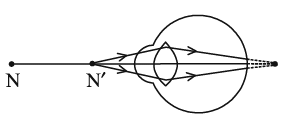 (i) Name the defect of vision represented in the diagram. Give reason for your answer.
(i) Name the defect of vision represented in the diagram. Give reason for your answer.
(ii) List two causes of this defect.
(iii) With the help of a diagram show how this defect of vision is corrected.
 View Answer
View Answer 
Ans: (i) Hypermetropia or Far-sightedness.
Reason – Image is formed behind the retina. Near point for the person is farther away from the normal near point (25 cm)
(ii)
- Focal length of the eye lens is too long.
- The eyeball has become too small.
(iii)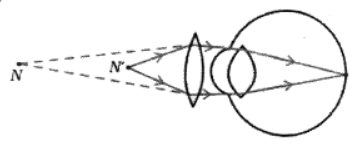 N = Near point of a hypermetropic eye
N = Near point of a hypermetropic eye
N’= Near point of a normal eye
Q3: Consider the following statements in the context of human eye: (2024)
(A) The diameter of the eye ball is about 2.3 cm.
(B) Iris is a dark muscular diaphragm that controls the size of the pupil.
(C) Most of the refraction for the light rays entering the eye occurs at the crystalline lens.
(D) While focusing on the objects at different distances the distance between the crystalline lens and the retina is adjusted by ciliary muscles.
The correct statements are —
(a) (A) and (B)
(b) (A), (B) and (C)
(c) (B), (C) and (D)
(d) (A), (C) and (D)
 View Answer
View Answer 
Ans: (a)
Adult eyeballs measure around 2.3 cm in diameter. The iris is the dark muscular diaphragm, whereas the ciliary muscle adjusts the focal length to focus images on the retina. The eye's initial surface, where light transitions from air to the cornea, has the most substantial shift in its index of refraction. The cornea accounts for around 80% of refraction, whereas the inner crystalline lens accounts for 20%.
Q4: Assertion - Reason based questions: (2024)
These questions consist of two statements — Assertion (A) and Reason (R). Answer these questions selecting the appropriate option given below :
Assertion (A): Myopic eye cannot see distant objects distinctly.
Reason (R): For the correction of myopia converging lenses of appropriate power are prescribed by eye-surgeons.
(a) Both (A) and (R) are true and (R) is the correct explanation of (A).
(b) Both (A) and (R) are true, but (R) is not the correct explanation of (A).
(c) (A) is true, but (R) is false.
(d) (A) is false, but (R) is true.
 View Answer
View Answer 
Ans: (c)
The assertion (A) states that a myopic eye, or near sighted eye, cannot see distant objects clearly, which is true. However, the reason (R) claims that converging lenses are used to correct myopia, which is false; instead, diverging lenses are prescribed for myopia to help the eye focus on distant objects. Thus, the answer is (c) because (A) is true, but (R) is false.
Q5: When do we say that a particular person is suffering from hypermetropia? List two causes of this defect. Name the type of lens used to correct this defect. (CBSE 2024)
 View Answer
View Answer 
Ans: When he cannot see nearby objects distinctly but can see far object clearly.
2 causes:
(i) Focal length of the eye lens is too long.
(ii) Eyeball becomes too small.
lens used to correct this defect is Convex or Converging lens
Q6: (a) Define the term power of accommodation of human eye. Write the name of the part of eye which plays a major role in the process of accommodation and explain what happens when human eye focuses (i) nearby objects and (ii) distant objects.
OR
(b) Draw a ray diagram to show the formation of a rainbow in the sky. On this diagram mark A — where dispersion of light occurs, B — where internal reflection of light occurs and C — where refraction of light occurs. List two necessary conditions to observe a rainbow. (2024)
 View Answer
View Answer 
- The ability of the eye lens to adjust its focal length, so as to clearly focus rays coming from distant as well as near objects on the retina, is called the power of accommodation of the eye.
- Ciliary muscles play a major role in maintaining power of accommodation.
(ii) While focusing on distant objects ciliary muscles relax, eye lens becomes thin and its focal length increases.
OR
(b)
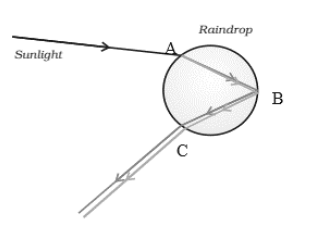
Two conditions:
(i) The Presence of tiny water droplets in the atmosphere.
(ii) Position of Sun at the back(behind) of the observer.
Q7: Name and explain the phenomenon of light due to which the path of a beam of light becomes visible when it enters a smoke filled room through a small hole. Also state the dependence of colour of the light we receive on the size of the particle of the medium through which the beam of light passes. (CBSE 2024)
 View Answer
View Answer 
Ans:
The phenomenon responsible is the Tyndall Effect, where light scatters due to tiny particles in the medium, making the beam visible in a smoke-filled room.Dependence on Particle Size:
- Small Particles – Scatter shorter wavelengths (blue/violet) more, making the sky appear blue.
- Medium Particles – Scatter all wavelengths almost equally, making the light appear white.
- Large Particles – Scatter all wavelengths equally, giving a white or greyish appearance, like clouds.
Q8: When a beam of white light passes through a region having very fine dust particles, the colour of light mainly scattered in that region is: (2024)
(a) Red
(b) Orange
(c) Blue
(d) Yellow
 View Answer
View Answer 
Ans: (c)
When a beam of white light passes through an area with fine dust particles, the color of light that gets scattered the most is blue. This happens because shorter wavelengths of light, like blue, scatter more easily than longer wavelengths, like red or orange. Therefore, blue light is not visible in such conditions.
Q9: Define the term power of accommodation of human eye. What happens to the image distance in the eye when we increase the distance of an object from the eye ? Name and explain the role of the part of human eye responsible for it in this case. (2024)
 View Answer
View Answer 
Ans:
- Power of Accommodation – The ability of the eye lens to adjust its focal length to focus objects at different distances on the retina.
- Image Distance – Remains unchanged as the image always forms on the retina.
- Role of Ciliary Muscles:
- For Distant Objects – Ciliary muscles relax, lens becomes thin, focal length increases.
- For Nearby Objects – Ciliary muscles contract, lens becomes thick, focal length decreases.
Q10: (a) Study the diagram given below and answer the questions that follow: (2024)
 (i) Name the defect of vision depicted in this diagram stating the part of the eye responsible for this condition. (ii) List two causes of this defect. (iii) Name the type of lens used to correct this defect and state its role in this case.
(i) Name the defect of vision depicted in this diagram stating the part of the eye responsible for this condition. (ii) List two causes of this defect. (iii) Name the type of lens used to correct this defect and state its role in this case.
OR
(b) What is dispersion of white light? State its cause. Draw a diagram to show dispersion of a beam of white light by a glass prism.
 View Answer
View Answer 
Ans:
(a) Defect of Vision
(i) Name & Responsible Part:
- Hypermetropia (Farsightedness) – Caused by ciliary muscles/eye lens.
(ii) Causes:
- Focal length of the eye lens is too long.
- Eyeball is too small, forming the image behind the retina.
(iii) Correction:
- Convex lens (Converging lens) decreases the focal length, helping focus the image on the retina.
(b) Dispersion of White Light
- Definition: Splitting of white light into seven colours when passing through a prism.
- Cause: Different colours bend at different angles due to varying wavelengths.
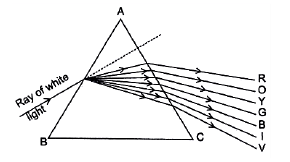
Q11: For Q. Nos.11 and 12, two statements are given - One labelled as Assertion (A) and the other labelled as Reason (R). Select the correct answer to these questions from the codes (a), (b), (c) and (d) as given below: (2024)
Assertion (A): The rainbow is a natural spectrum of sunlight in the sky.
Reason (R): Rainbow is formed in the sky when the sun is overhead and water droplets are also present in air.
(a) Both Assertion (A) and Reason (R) are true and Reason (R) is the correct explanation of the Assertion (A).
(b) Both Assertion (A) and Reason (R) are true, but Reason (R) is not the correct explanation of the Assertion (A).
(c) Assertion (A) is true, but Reason (R) is false.
(d) Assertion (A) is false, but Reason (R) is true.
 View Answer
View Answer 
Ans: (c)
- Assertion (A): True. A rainbow is a natural spectrum formed by the dispersion, refraction, and internal reflection of sunlight by water droplets.
- Reason (R): False. Rainbows form when the sun is behind the observer at a low angle (typically ~42° above the horizon for the primary rainbow), not overhead, and water droplets are present in the atmosphere.
Q12: Assertion (A) and Reason (R), answer these questions selecting the appropriate option given below: (CBSE 2024)
Assertion (A): Red light signals are used to stop the vehicles on the road.
Reason (R): Red coloured light is scattered the most so as to be visible from a large distance.
(a) Both (A) and (R) are true and (R) is the correct explanation of (A).
(b) Both (A) and (R) are true and (R) is not correct explanation of (A).
(c) (A) is true, but (R) is false.
(d) (A) is false, but (R) is true.
 View Answer
View Answer 
Ans: (c)
The assertion (A) is true because red light signals are indeed used to indicate that vehicles should stop. However, the reason (R) is false; red light is actually scattered the least among the visible colors due to longer wavelength , which is why it can be seen from a distance without much scattering. Therefore, the correct answer is (c), as (A) is true, but (R) is false.
Previous Year Questions 2023
Q1: Observe the following diagram and answer the questions following it :
(i) Identify the defect of vision shown.
(ii) List its two causes.
(iii) Name the type of lens used for the correction of this defect. (2023)
 View Answer
View Answer 
Ans:
- Student is suffering from myopia.
- The two possible reasons due to which the defect of vision arises are:
- excessive curvature of the eye-lens
- elongation of the eye-ball
- A student with myopia has the far point nearer than infinity, thus, the image of a distant object is formed in front of the retina.
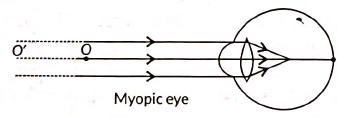
Correction of myopia: This defect can be corrected by using a concave lens of suitable power as it brings the image back on to the retina, thus the defect is corrected.
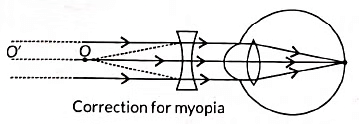
Q2: Observe the following diagram showing an image formation in an eye:
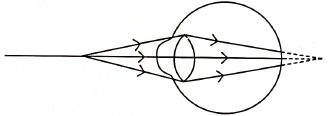
(a) Identify the defect of vision shown in the figure.
(b) List its two causes and suggest a suitable corrective lens to overcome this defect (2023)
 View Answer
View Answer 
Ans: (a) Hypermetropia
(b) Hypermetropia is caused due to following reasons:
(i) Shortening of the eyeball
(ii) Focal length of crystalline lens is too long
It is corrected by using a convex lens which converges and shifts the image to the retina from behind.
Q3: Define the term dispersion of white light. State the colour which bends (i) the most, and (ii) the least while passing through a glass prism. Draw a diagram to show the dispersion of white light. (2023)
 View Answer
View Answer 
Ans: 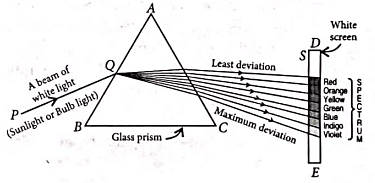 (i) The phenomenon of the splitting up of the white light into its constituent's colours is called dispersion of light. Dispersion of light is caused due to different constituents and colours of light after different refractive indices to the material of the prism.
(i) The phenomenon of the splitting up of the white light into its constituent's colours is called dispersion of light. Dispersion of light is caused due to different constituents and colours of light after different refractive indices to the material of the prism.
(ii) The formation of a rainbow is caused by the dispersion of the white sunlight into its constituent colours.
(iii) Based on the dispersion of white light into its constituent's colours, we can conclude that
(a) The white light consists of seven colours.
(b) The violet light suffers maximum deviations and the red light suffers minimum deviation.
Q4: What is a rainbow? Draw a labelled diagram to show its formation. (2023)
 View Answer
View Answer 
Ans: After a rain-shower, the sunlight gets dispersed by tiny droplets, present in the atmosphere. The water droplets act like small glass prisms. They refract and disperse the incident sunlight, then reflect it internally, and finally refract it again when it comes out of the raindrop. Due to dispersion or light and internal reflection, different colours reach the observer's eye, which is called a rainbow.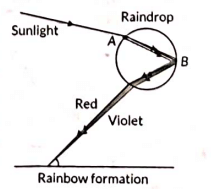
Q5: The colour of the clear sky from the Earth appears blue but from space, it appears black. Why? (2023)
 View Answer
View Answer 
Ans: As our earth has an atmosphere and space has no atmosphere, the sunlight scatters by the particles in the atmosphere. The amount of scattering of light is inversely proportional to wavelength thus violet, and blue colours scatter more than red and hence the colour of the sky appears blue from the earth.
Q6: A narrow beam XY of white light is passing through a glass prism ABC as shown in the diagram:
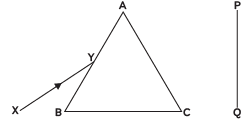
Trace it on your answer sheet and show the path of the emergent beam as observed on the screen PQ. Name the phenomenon observed and state its cause. (CBSE 2023)
 View Answer
View Answer 
Ans:
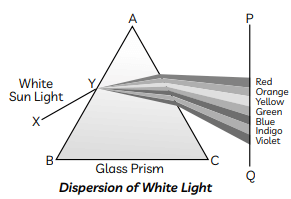
The phenomenon of the splitting up of the white light into its constituent colours is called dispersion of light. Dispersion of light is caused when different constituent colours of light offer different refractive indices to the material of the prism.
Q7: Give reasons for the following.
(A) Danger signals installed at airports and at the top of tall buildings are of red colour.
(B) The sky appears dark to the passengers flying at very high altitudes.
(C) The path of a beam of light passing through a colloidal solution is visible. (CBSE 2023)
 View Answer
View Answer 
Ans: (A) Red danger signals are used because red light has the longest wavelength in the visible spectrum and is scattered the least by atmospheric particles, fog, or smoke. This allows red light to be visible from greater distances, making it effective for warning signals.
(B) At higher altitude either the atmospheric medium is very rare or there are no particles present/no atmosphere, thus the scattering of light taking place is not enough at such heights or no scattering of sunlight takes place. Hence, the sky appears dark to the passengers flying at very high altitude.
(C) Tyndall effect deals with the phenomenon of scattering of light by colloidal particles. When a fine beam of sunlight enters a room, the particles present in the room become visible due to scattering of light by these particles. When sunlight passes through a canopy of a dense forest, tiny water droplets in the mist scatter light.
Q8: It is observed that the power of an eye to see nearby objects as well as far off objects diminishes with age.
(A) Give reason for the above statement.
(B) Name the defect that is likely to arise in the eyes in such a condition.
(C) Draw a labelled ray diagram to show the type of corrective lens used for restoring the vision of such an eye. (CBSE 2023)
 View Answer
View Answer 
Ans: (A) We know that the ability of the accommodation factor to alter the focal length declines with ageing. Without corrective spectacles, aged people have difficulty seeing surrounding objects clearly.
(B) The person is suffering from presbyopia.
(C)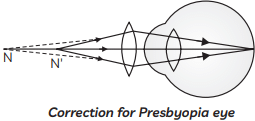
Previous Year Questions 2022
Q1: In the diagram given below. X and Y are the end colours of the spectrum of white light. The colour of 'Y' represents the (2022)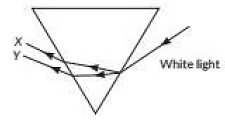
(a) Colour of sky as seen from earth during the day
(b) Colour of the sky as seen from the moon
(c) Colour used to paint the danger signals
(d) Colour of sun at the time of noon.
 View Answer
View Answer 
Ans: (c)
Sol: Red colour is used to paint the danger signals. As live know, visible spectrum has violet indigo, blue, green, yellow. orange and red colour and these colours are arranged with red on the top and violet at the bottom (near base of the prism) on the basis of wavelength and frequency, and among these colours red colour has largest wavelength (≈ 750 nm). Thus, here Y will be red.
Previous Year Questions 2021
Q1: Assertion (A): Sky appears blue in the day time. Reason(R) : White light is composed of seven colours. (2021)
(a) Both A and R are true and R is the correct explanation of A
(b) Both A and R are true, and R is not correct explanation of A
(c) (A) is true, but R is false.
(d) (A) is false but R is true.
 View Answer
View Answer 
Ans: (b)
Sol: The blue colour of clear sky is due to scattering of sunlight
Q2: Which of the following statements is NOT true for the scattering of light?
(a) Colour of the scattered light depends on the size of particles of the atmosphere.
(b) Red light is least scattered in the atmosphere.
(c) Scattering of light takes place as various colours of white light travel with different speed in air.
(d) The fine particles in the atmospheric air scatter the blue light more strongly than red. So the scattered blue light enters our eyes. (CBSE Term-1 2021)
 View Answer
View Answer 
Ans: (c)
(a) This statement is true. The color of scattered light depends on the size of the particles in the atmosphere. Smaller particles scatter shorter wavelengths (like blue) more than longer wavelengths (like red).
(b) This statement is true. Red light is least scattered in the atmosphere because it has a longer wavelength.
(c) This statement is NOT true. All colors of white light travel at the same speed in air. Scattering occurs due to the interaction of light with particles, not because of a difference in the speed of various colors in air.
(d) This statement is true. Fine particles in the atmosphere scatter blue light more strongly than red light, which is why the sky appears blue to our eyes.
Therefore, the correct answer is (c) Scattering of light takes place as various colours of white light travel with different speed in air.
Previous Year Questions 2020
Q1: Why is the Tyndall effect shown by colloidal particles? State four instances of observing the Tyndall effect. (2020) View Answer
View Answer 
Ans: The phenomenon of scattering of light by the colloidal particles gives rise to the Tyndall effect. When a beam of light strikes colloidal particles, the path of the beam becomes visible. This is known as the Tyndall effect. This phenomenon can be observed when
(i) Sunlight passes through a canopy of dense forest when tiny water droplets in the mist scatter light.
(ii) torch light is switched on in a foggy environment, light rays are visible after being scattered by the fog particles in the surrounding air.
(iii) a fine beam of sunlight enters a smoke-filled room through a small hole.
(iv) Shining a flashlight beam into a glass of dilated milk produces a Tyndall effect.
Previous Year Questions 2019
Q1: Define the term power of accommodation. Write the modification in the curvature of the eye which enables us to see the nearby objects. What are the limits of the accommodation power of a healthy normal human eye? (CBSE 2019) View Answer
View Answer 
Ans:
- Accommodation power is the property of the eye lens to adjust its focal length to focus objects situated at different distances from the eye on the retina.
- When the ciliary muscles are relaxed, the eye lens becomes thin and its focal length is maximum and equal to the diameter of the eyeball. In this condition, one can see distant objects.
- At the time of looking at nearby objects, the ciliary muscles of the eye contract and the eye lens become thicker. Consequently, the focal length of the eye lens decreases and nearby objects are focussed at the retina.
- There are definite limits to accommodation power for a healthy normal eye. The farthest distance, up to which an eye can see objects clearly, is called the far point of the eye and its value is infinity.
- The minimum distance, up to which an eye can see distinctly, is known as the near point of the eye and its value is 25 cm for a normal eye.
Q2: When do we consider a person to be myopic? List two causes of this defect.
Explain using a ray diagram how can this defect of an eye be corrected. (CBSE 2019)
 View Answer
View Answer 
Ans:
- A person is said to have a myopic vision if he can see objects situated near the eye clearly but cannot see distant objects.
- If a person can see clearly up to a distance x from the eye then it means that the far point of the eye has shifted from infinity to a point O situated at distance V from the eye.
- Light rays coming from a distant object (u = ∞) are focussed in front of the retina of the eye.
- Two possible causes of myopia are :
- Either the power of the eye lens has become more than its normal value due to excessive curvature of the cornea (focal length of eye lens has decreased) or
- Elongation of the eyeball due to some genetic defect.
- To rectify this defect a concave lens of focal length f is used, which may form the virtual image of the distant object at the far point of the defective eye (i.e., u = - ∞ and v = - x) so that now the defective eye may form the image at the retina.
- Obviously, by using the lens formula, we have
 ⇒ f = -x
⇒ f = -xThe ray diagram of the defective eye and its rectification are shown here.
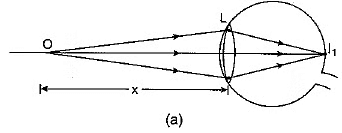
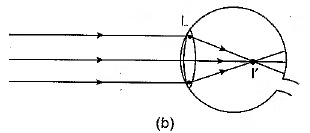
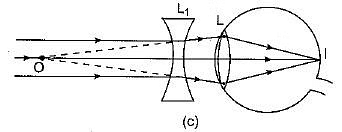
Q3: Name two defects of vision. Mention their cause and the type of lenses used to correct them. (CBSE 2019)
 View Answer
View Answer 
Ans: Two main defects of vision, their cause and correction are as follows :
(1) Myopia - In myopia or near-sightedness (or short-sightedness), a person can see nearby objects clearly but cannot see distant objects distinctly. For a myopic eye, the far point is not at infinity but has shifted nearer to the eye.
Myopia arises due to either (i) excessive curvature of the cornea, or (ii) elongation of the eyeball.
Myopia can be corrected by using a concave lens whose focal length has the same numerical value as the distance of the far point of the defective eye.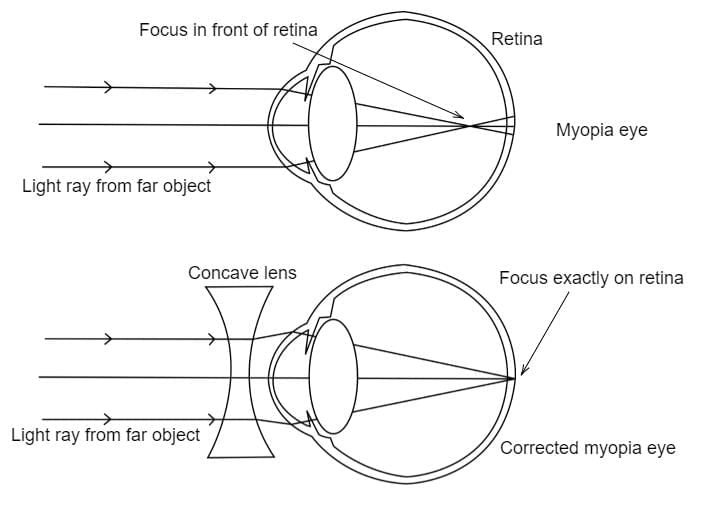
(2) Hypermetropia -In hypermetropia or long-sightedness, a person can see distant objects distinctly but cannot see nearby objects so clearly. For a longsighted eye, the near point is not at 25 cm but has shifted away from the eye.
Hypermetropia arises either because
(i) the focal length of the eye lens is too large, or
(ii) contraction of the eyeball.
Hypermetropia can be corrected by using a suitable convex lens, which forms a virtual image of the object situated at 25 cm at the near point of the defective eye so that the eye lens can focus it on the retina.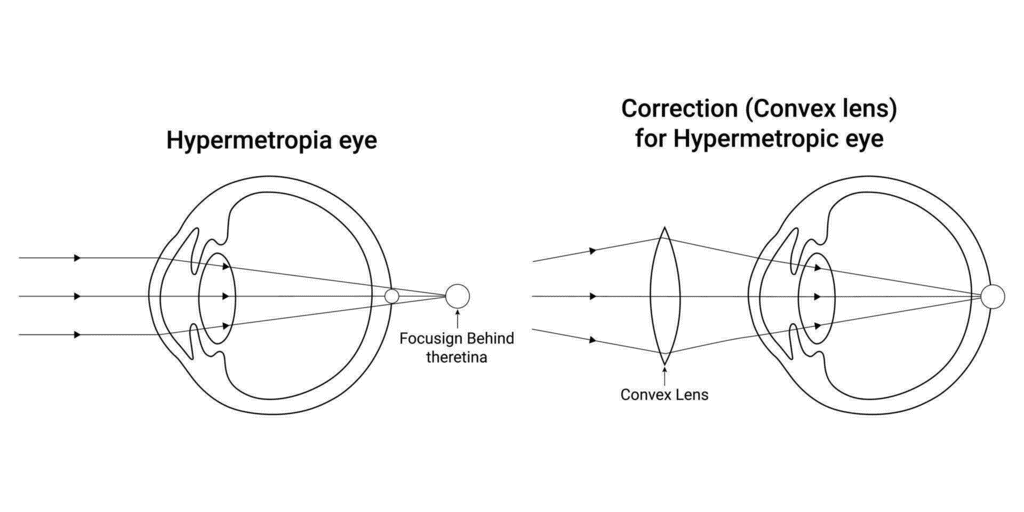
Q4: What is a rainbow? Draw a labelled diagram to show the formation of a rainbow. (CBSE 2019)
Or
Describe the formation of the rainbow in the sky with the help of a diagram.
 View Answer
View Answer 
Ans: A rainbow is a natural spectrum appearing in the sky after a rain shower. A Rainbow is caused by the dispersion of sunlight by tiny water droplets hanging in the atmosphere after a rain shower. The water droplets act like small prisms. As shown in the figure, the water droplets refract and disperse the incident sunlight. These rays are then reflected internally and finally refracted again and come out of raindrops. Due to the dispersion and internal reflection of light different colours reach the observer’s eye and a rainbow is seen.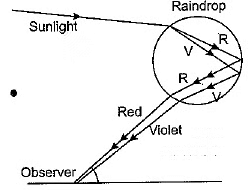 An important point to be noted here is that a rainbow is always formed in a direction opposite to that of the Sun.
An important point to be noted here is that a rainbow is always formed in a direction opposite to that of the Sun.
Q5: What is atmospheric refraction? Briefly explain. Why does the apparent position of a star appear different from its true position? (CBSE 2019)
 View Answer
View Answer 
Ans: The atmospheric air layer just near the earth's surface is comparatively denser and the upper layers of the atmosphere are successively rarer and more rarer. Hence, a light ray passing through atmospheric air undergoes refraction. Since the physical conditions of air are not stationary, the apparent position of the distant object, as seen through the air, fluctuates. It is known as an effect of atmospheric refraction.
Light coming from a distant star entering into the earth’s atmosphere gradually bends towards the normal on account of atmospheric refraction. Hence, the star appears slightly higher than its actual position when viewed near the horizon.
Q6: The stars appear higher from the horizon than they are. Explain why it is so. (CBSE 2019)
 View Answer
View Answer 
Ans: As we go up and up in earth’s atmosphere, it goes on becoming rarer and more rarer. As a result, the atmospheric layer near the earth’s surface has a maximum refractive index and the refractive index gradually decreases with an increase in height.
When a light ray from a star enters into earth’s atmosphere, it travels from a rarer to denser medium and hence continues to bend towards the normal. As a result, an observer on Earth considers the apparent position of a star to be at a higher altitude.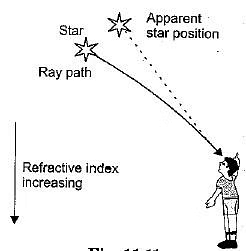
Q7: What happens to the image distance in the normal human eye when we decrease the distance of an object, say 10 m to 1 m? Justify your answer. (Delhi 2019)
 View Answer
View Answer 
Ans: There is no change in the image distance in the eye. The eye lens can adjust its focal length called accommodation. When object distance decreases, ciliary muscles contract and lens becomes thick and its focal length decreases. It facilitates near vision.
Q8: Due to the gradual weakening of ciliary muscles and diminishing flexibility of the eye lens a certain defect of vision arises. Write the name of this defect. Name the type of lens required by such persons to improve their vision. Explain the structure and function of such a lens. (Delhi 2019)
 View Answer
View Answer 
Ans:
- The defect of vision is Presbyopia.
- A bifocal lens is required by such persons to improve their vision.
Structure and function of Bifocal lens
- To view far-off objects, the upper part of the bifocal lens is a Concave or Diverging lens.
- To facilitate or view nearby objects, the Lower part of the bifocal lens is Convex or Converging lens.
Q9: (A) State the role of ciliary muscles present in our eye.
(B) Identify the defect of vision in each of the given cases and suggest its corrective measure.
(i) The eye lens has become milky and cloudy.
(ii) The eye lens has excessive curvature.
(iii) The eye lens has large focal length (longer than normal).
(iv) Ciliary muscles have weakened.
 View Answer
View Answer 
Ans: (A) Ciliary muscles relax and contract to adjust/modify the focal length of eye lens.
(B) Eye defects and corrective measures: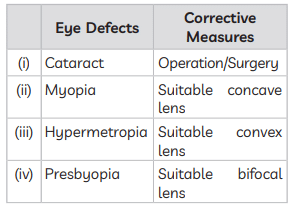
Q10: (A) With the help of diagram explain Isaac Newton’s experiment that led to the idea that the sunlight is made up of seven colours.
(B) What is atmospheric refraction? List two natural phenomena based on atmospheric refraction.
 View Answer
View Answer 
Ans: (A) Issac Newton was the first to use a glass prism to obtain the spectrum of white light. He tried to split various colours of the spectrum of white light by using another similar prism, but he could not get any more colours. Thus he proved that sunlight is made of seven colours.
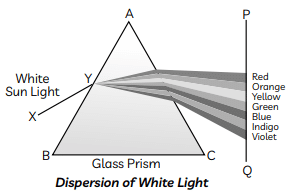
(B) Atmospheric Refraction: It is the refraction of light by the earth’s atmospheric layers having varying refractive indices.
Two natural phenomena:
(1) Twinkling of stars,
(2) Advanced sunrise and delayed sunset.
Previous Year Questions 2018
Q1: (a) Write the function of each of the following parts of the human eye :(i) Cornea
(ii) Iris
(iii) Crystalline lens
(iv) Ciliary muscles.
(b) Why does the sun appear reddish early in the morning? Will this phenomenon be observed by an astronaut on the Moon? Give a reason to justify your answer. (CBSE 2018)
 View Answer
View Answer 
Ans: (a) The function of the given parts is stated below:
(i) The cornea is the outer bulged-out thin transparent layer of the eye and provides most of the refraction for the light entering into the eye.
(ii) The iris controls the size of the pupil of the eye.
(iii) The crystalline lens provides the finer adjustment of the focal length required to focus objects situated at different distances in front of the eye on the retina.
(iv) The ciliary muscles help in controlling the curvature of the crystalline lens and thus can change the power of the crystalline lens.
(b) In the early morning, the Sun is situated near the horizon. Light from the Sun passes through thicker layers of air and covers a larger distance in the Earth's atmosphere before reaching our eyes. While passing through atmosphere blue light is mostly scattered away and the Sun appear reddish as shown in Fig.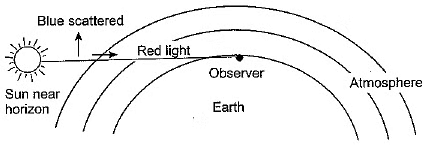
The phenomenon is not observed by an observer on the Moon because the Moon has no atmosphere of its own and hence no scattering of light is possible.
Q2: (a) What is meant by the term power of accommodation? Name the component of the eye that is responsible for the power of accommodation.
(b) A student sitting at the back bench in a class has difficulty in reading. What could be his defect of vision? Draw a ray diagram to illustrate the image formation of the blackboard when he is seated at the (i) back seat and (ii) front seat. State two possible causes of this defect. Explain the method of correcting this defect with the help of a ray diagram. (CBSE 2018)
 View Answer
View Answer 
Ans: (a) Power of accommodation: The ability of an eye lens to adjust its focal length to form a sharp image of the object at varying distances on the retina is called the power of accommodation. The ciliary muscles of the eye are responsible for changing the focal length of the eye lens.
(b)
- The student is suffering from myopia shortsightedness or nearsightedness.
- When a student is seated in the back seat.

In this case, the student is suffering from myopia and has a short focal length of the eye lens.
(ii) When a student is seated in the front seat.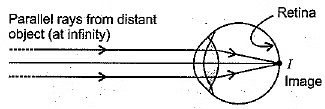
Causes:
(i) Excessive curvature of the eye lens
(ii) Elongation of eyeball.
The defect is corrected by using a concave lens of suitable power placed in front of the eye as shown below. It diverges the rays and forms a virtual image of a distant object at the far point of the myopic eye. These diverged rays enter the eye and form the image on the retina. Thus, the concave lens shifts the image back onto the retina instead of in front of it and the defect is corrected.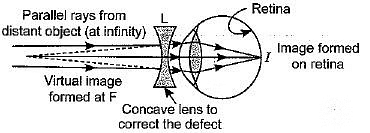
Q3: (a) What is presbyopia? State its cause. How is it corrected?
(b) Why does the sun appear reddish early in the morning? Explain with the help of a labelled diagram. (CBSE 2018C)
 View Answer
View Answer 
Ans: (a) (i) Presbyopia
- Presbyopia is a condition that occurs as a part of normal ageing.
Due to loss of power of accommodation of the eye, with age, objects at a normal near working distance will appear blurry. The near point gradually recedes away. This defect of the eye is called Presbyopia. - Sometimes, a person may suffer from both myopia and hypermetropia.
(ii) Presbyopia is caused due to
- weakening of ciliary muscles, and
- eye lens becomes less flexible and elastic, i.e. reducing the ability of the eye lens to change its curvature with the help of ciliary muscles.
(iii) A bifocal lens will be required to see nearby as well as distant objects. For myopic defects, the upper part of the bifocal lens consists of a concave lens used for distant vision and to correct hypermetropia, the lower part of the bifocal lens consists of a convex lens. It facilitates near vision.
(b) At the time of sunrise/sunset, the sun is near the horizon, so the sun's rays have to travel through a larger atmospheric distance. The fine particles of the atmosphere scatter away the blue component and other shorter wavelengths of the sunlight. As λb < λr, only red colour having a longer wavelength and is least scattered, reaches our eyes. Hence, the sun appears red at sunrise or sunset.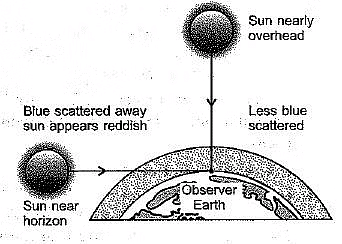
Previous Year Questions 2017
Q1: What eye defect is hypermetropia? What are its two possible causes? Describe with a ray diagram how this defect of vision can be corrected by using an appropriate lens. (CBSE 2017) View Answer
View Answer 
Ans: Hypermetropia or long-sightedness is that defect of vision in which the defective eye can see distant objects distinctly but is unable to see distinctly an object placed near his eye. For a nearby object, the image is formed behind the retina.
Two possible causes of this defect of vision are :
(i) The power of the eye lens is less (or the focal length of the eye lens is more) due to less curvature of the cornea.
(ii) The size of the eyeball is shortened.
The hypermetropia defect can be corrected by using a converging (convex) lens of appropriate power.
Ray diagrams showing the defect and its correction are
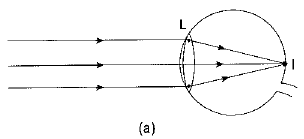
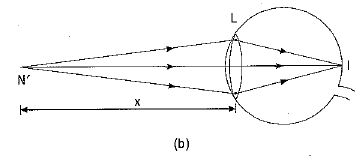
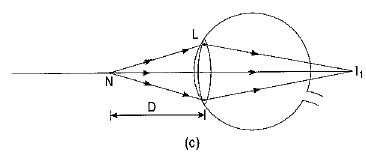
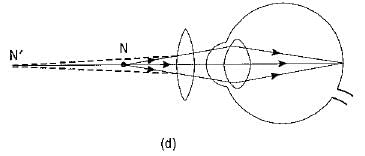
Q2: What is dispersion of white light? Draw a neat diagram to show the dispersion of white light by a glass prism. What is the cause of dispersion? (CBSE 2017)
 View Answer
View Answer 
Ans: When a beam of white light passes through a glass prism it splits up into its constituent seven colours. The splitting of white light into its constituent colours when light passes through a dispersive medium is called “dispersion of light”. The seven colours, usually expressed as ‘VTBGYOR’ constitute the spectrum of white light.
The ray diagram showing dispersion is given here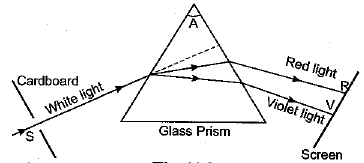 Cause of Dispersion: When a beam of white light enters a glass prism (or any other dispersive medium), the light ray bends towards the normal one entering into the glass. However, different colours of light bend through different angles concerning the incident ray The red light bends the least while the violet light bends the most. So, rays of different colours emerge along different paths and, thus, become distinct. Hence, dispersion is caused and a spectrum is formed.
Cause of Dispersion: When a beam of white light enters a glass prism (or any other dispersive medium), the light ray bends towards the normal one entering into the glass. However, different colours of light bend through different angles concerning the incident ray The red light bends the least while the violet light bends the most. So, rays of different colours emerge along different paths and, thus, become distinct. Hence, dispersion is caused and a spectrum is formed.
Q3: State the cause of dispersion of white light by a glass prism. How did Newton, using two identical glass prisms, show that white light is made of seven colours? Draw a ray diagram to show the path of a narrow beam of white light, through a combination of two identical prisms arranged together in an inverted position concerning each other, when it is allowed to fall obliquely on one of the faces of the first prism of the combination. (AI 2017)
 View Answer
View Answer 
Ans: Cause of dispersion: From Snell’s law of refraction, the angle of refraction of light in a prism depends on the refractive index of the prism material. Moreover, the refractive index of the material varies inversely with the speed of light and also varies inversely with the wavelength of light. Hence, different colours of white light bend through different angles concerning the incident light, as they pass through the glass prism.
Newton Experiment: Consider a prism A. When a beam of white light falls obliquely on one of the faces of this prism, it splits up into seven constituent colours. The violet colour deviates the most and the red colour deviates the least.
If another identical prism B is placed in an inverted position concerning the first prism A, the constituent coloured rays that emerge out of prism A will be made to merge to come out as a beam of white light, as shown below.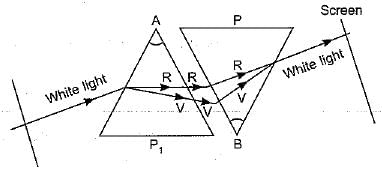
Q4: Name the type of defect of vision a person is suffering from, if he uses convex lenses in his spectacles for the correction of his vision. If the power of the lenses is +0.5 D, find the focal length of the lenses. (AI2017C)
 View Answer
View Answer 
Ans: The defect of vision is hypermetropia.
Focal length of lenses,
Q5: A student traces the path of a ray of light through a glass prism for different angles of incidence. He analyses each diagram and draws the following conclusion:
(I) On entering prism, the light ray bends towards its base.
(II) Light ray suffers refraction at the point of incidence and point of emergence while passing through the prism.
(III) Emergent ray bends at certain angle to the direction of the incident ray.
(IV)While emerging from the prism, the light ray bends towards the vertex of the prism.
Out of the given inferences, the correct ones are:
(a) (I), (II) and (III)
(b) (I), (III) and (IV )
(c) (II), (III) and (IV )
(d) (I) and (IV ) (CBSE 2017)
 View Answer
View Answer 
Ans: (a)
(I) On entering the prism, the light ray bends towards its base: This is correct. When light enters a denser medium (the prism) at an angle, it bends towards the base of the prism due to refraction.
(II) The light ray suffers refraction at the point of incidence and point of emergence while passing through the prism: This is correct. The ray undergoes refraction at both the surfaces of the prism — first when it enters the prism and again when it exits.
(III) The emergent ray bends at a certain angle to the direction of the incident ray: This is correct. The emergent ray is deviated from the original path of the incident ray, resulting in a measurable angle of deviation.
(IV) While emerging from the prism, the light ray bends towards the vertex of the prism: This is incorrect. When the ray emerges from the prism, it actually bends away from the normal (towards the base of the prism) as it moves from a denser to a rarer medium.
Thus, the correct inferences are (I), (II), and (III), making the correct answer (a) (I), (II) and (III).
Q6: What is scattering of light? Why is the colour of the clear sky blue? Explain. (CBSE 2017)
 View Answer
View Answer 
Ans: Scattering of light is the phenomenon of change in the direction of light on striking an obstacle like an atom, a molecule, dust particle, water droplet, etc. The blue colour of the sky is due to the scattering of sunlight by a large number of molecules such as fine dust particles, gases, water vapour, etc. present in Earth’s atmosphere. Due to the very small size of the scatterer as compared to the wavelength of light, light of smaller wavelength, such as blue, is scattered the most as compared to light of longer wavelength.
Q7: Due to gradual weakening of ciliary muscles and diminishing flexibility of the eye lens a certain defect of vision arises. Write the name of this defect. Name the type of lens required by such persons to improve the vision. Explain the structure and function of such a lens. (CBSE 2017)
 View Answer
View Answer 
Ans: The defect of vision that arises due to gradual weakening of ciliary muscles and diminishing flexibility of the eye lens is presbyopia. Most people find it difficult to see nearby objects comfortably and clearly without using corrective lenses. This is corrected by using convex lens of appropriate power. However, sometimes people may suffer from both myopia and hypermetropia. This can be corrected by using a bifocal lens. A bifocal lens consists of two parts – the upper part is concave lens and lower part is convex lens. The upper part is for viewing distant objects and the lower part facilitates near vision.
Q8: Varun instead of copying from the black board used to copy regularly from the notebook of his friend, Sudhir with whom he sat on the same desk. Sudhir told the teacher about it. The teacher asked Varun to get his eyes checked by a doctor and explained to the whole class the reason why Varun copied from Sudhir’s notebook.
(A) What in your view, is wrong with Varun’s eyes and how can it be corrected?
(B) If the doctor prescribes Varun to use lenses of power – 0.5 D, what is the type of the lenses?
(C) Write the values displayed by Sudhir and his teacher.
 View Answer
View Answer 
Ans: (A) Varun is suffering from the defect of vision called myopia. Myopia can be corrected by using concave lens of appropriate power.
(B) Power of lens = – 0.5 D. This means it is a concave lens.
(C) Values displayed by Sudhir: Concerned, helpful, compassionate
Values displayed by teacher: Concerned, Knowledgeable.
Q9: Curvature of eye lens of human eye can be modified by ciliary muscles to some extent so that its focal length is changed as per requirement. How will the curvature and focal length of eye lens change when:
(A) a distant object is to be seen, and,
(B) a nearby object is to be seen clearly? Write the reason why a normal eye is not able to see clearly, the objects placed closer than 25 cm, without any strain on the eye.
 View Answer
View Answer 
Ans: (A) When we see a distant object, the muscles relax and the lens become thin and its focal length increases.
(B) When we see a nearby object, the ciliary muscles contract, this increases the curvature of the eye lens and it becomes thicker. Consequently the focal length of the eye lens decreases. A normal eye is unable to clearly see the objects placed closer than 25 cm because the ciliary muscles of eyes are unable to contract beyond a certain limit.
Previous Year Questions 2016
Q1: Describe an activity to show that the colours of white light split by a glass prism can be recombined to get white light by another identical glass prism. Also, draw a ray diagram to show the recombination of the spectrum of white light. (AI 2016) View Answer
View Answer 
Ans: Recombination of Colours: The colours of white light split by a glass prism can be recombined to get white light by another identical glass prism. Newton; demonstrated this phenomenon of recombination of the coloured rays of a spectrum to get back white light.
(а) A triangular prism ABC is placed on its base BC.
(b) A similar prism A 'B 'C ' is placed alongside its refracting surface in the opposite direction, i.e. in an inverted position concerning the first prism as shown in the figure.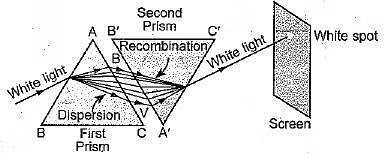 (c) A beam of white light entering the prism ABC undergoes refraction and is dispersed into its constituent seven colours.
(c) A beam of white light entering the prism ABC undergoes refraction and is dispersed into its constituent seven colours.
(d) These constituent seven coloured rays are incident on the second inverted prism A'B'C' and get further refracted.
(e) The second prism recombines them into a beam of white light that emerges from the other side of the second prism and falls on the screen.
(f) This is because the refraction or bending produced by the second inverted prism is equal and opposite to the refraction or bending produced by the first prism. This causes the seven colours to recombine.
(g) A white patch of light is formed on the screen placed beyond the second prism. This proves the phenomenon of recombination of the spectrum of white light.
Q2: What is the function of the retina in the human eye? (CBSE 2016)
 View Answer
View Answer 
Ans. The retina behaves like a light-sensitive screen, on which real and inverted image of any object situated in front of the eye is formed.
Q3: What is the function of the crystalline lens of the eye? (CBSE 2016)
 View Answer
View Answer 
Ans: It provides the fine adjustment of the focal length of the eye lens system to focus images of objects situated at different distances on the retina.
Q4: Write the function of the iris in the human eye. (CBSE 2016)
 View Answer
View Answer 
Ans: Iris controls the size of the pupil
Q5: State the role of ciliary muscles in the accommodation of the eye. (CBSE 2016)
 View Answer
View Answer 
Ans: Adjust/modify the shape (curvature) of the eye lens so that its focal length can be increased or decreased.
Q6: What are the values of (i) near point and (ii) far point of vision of a normal adult person? (CBSE 2016)
 View Answer
View Answer 
Ans: (i ) 25 cm, (ii ) infinity.
Q7: Name two possible causes of myopia. (CBSE 2016)
 View Answer
View Answer 
Ans: (i) Excessive curvature of the eye lens.
(ii) Elongation of the eyeball.
Q8: An old person is unable to see nearby objects as well as distant objects. What defect of vision he is suffering from? (CBSE 2016)
 View Answer
View Answer 
Ans: The old person is suffering from presbyopia.
Q9: Priya prefers to sit in the front row as she finds it difficult to read the blackboard from the last desk in her classroom. State the defect of vision she is suffering from. (CBSE 2016)
 View Answer
View Answer 
Ans: Priya is suffering from myopia (near-sightedness).
Q10: Name the component of white light that deviates (i) the least and (ii ) the most while passing through a glass prism. (CBSE 2016)
 View Answer
View Answer 
Ans: (e) Red light is deviated the least and Violet light is deviated the most.
Q11: What will be the colour of the sky when it is observed from a place in the absence of any atmosphere? (CBSE 2016)
 View Answer
View Answer 
Ans: Black (dark).
Q12: Why is the red colour selected for danger signal lights? (CBSE 2016)
 View Answer
View Answer 
Ans: Red light is least scattered by fog or smoke and can be easily seen from a distance.
Q13: (a) What is the function of the iris and pupil of the eye?
(b) How does the focal length of the eye lens change as per the distance of the object in front of the eye? (CBSE 2016)
 View Answer
View Answer 
Ans: (a) The iris controls the size of the pupil. It adjusts in size, and therefore, helps in regulating the amount of light entering the eye through a variable aperture ‘pupil’. When the fight is very bright, the pupil becomes very small. However, in dim fight, it opens up completely through the relaxation of the iris.
(b) The crystalline eye lens consists of a fibrous, jelly-like material. Its curvature can be modified to some extent by the ciliary muscles. The change in the curvature of the eye lens can change its focal length. When the muscles are relaxed, the lens is thin and its focal length is more (about 2.5 cm). When the ciliary muscles contract the eye lens becomes thicker. Consequently, the focal length of the eye lens decreases.
Q14: What is a prism? Draw a neat diagram to show the refraction of a light ray through a triangular glass prism. Define the angle of deviation. (CBSE 2016)
 View Answer
View Answer 
Ans: An optical prism has two triangular bases and three rectangular lateral surfaces, which are inclined to each other. The angle between its two lateral faces is called the angle of the prism.
The labelled diagram has been shown in Fig in which
∠PEN = ∠i = angle of incidence, ∠N'EF = ∠r = angle of refraction and ∠MFR = ∠e = angle of emergence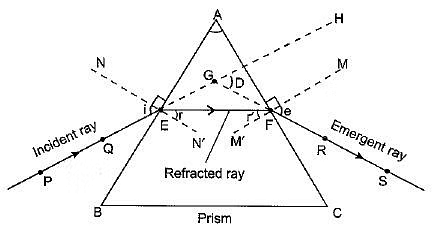 Whenever refraction of light takes place through a prism, the emergent ray bends towards the base of the prism. The angle between the directions of the incident ray and the emergent ray is called the angle of deviation D.
Whenever refraction of light takes place through a prism, the emergent ray bends towards the base of the prism. The angle between the directions of the incident ray and the emergent ray is called the angle of deviation D.
Q15: Explain why the planets do not twinkle but the stars twinkle. (CBSE 2016)
 View Answer
View Answer 
Ans: Stars are very far away from the earth and behave as almost a point object. The atmosphere is made of several layers and their refractive indices keep on changing continuously. So the light rays coming from the star keep on changing their paths continuously. As a consequence, the number of rays (or the light energy) entering the pupil of the eye changes with time and the stars appear twinkling.
A planet is comparatively nearer to the Earth and subtends a larger angle at the eye. So, it may be considered a collection of a large number of point-sized objects. Due to atmospheric refraction, the quantity of light coming from any one point-sized object changes with time but the total light entering the observer’s eye due to all these point objects remains almost the same. As a result, the planet does not twinkle.
Q16: Explain with the help of a diagram, how we are able to observe the sunrise about two minutes before the sun gets above the horizon. Hence, explain why does apparent duration of a day from sunrise to sunset is 4 minutes more than its actual duration. (CBSE 2016)
 View Answer
View Answer 
Ans: The air becomes rarer as its height above the earth increases. Its refractive index decreases. A ray of light from the Sun when it enters the atmosphere at the horizon gets refracted from a rarer to a denser medium. The rays, therefore gradually bend towards the normal and the Sun appears to be raised.
As a result, the Sun is visible to an observer nearly two minutes before actual sunrise at the horizon. Similarly, even after actual sunset, the Sun is seen by us for about 2 minutes. Thus, in effect, the Sun is seen for 4 minutes more. It means that the apparent duration of the day (from sunrise to sunset) has increased by 4 minutes more than its actual duration.
Q17: (a) What is the dispersion of white light? State its cause.
(b) “Rainbow is an example of dispersion of sunlight” Justify this statement by explaining, with the help of a labelled diagram, the formation of a rainbow in the sky. List two essential conditions for observing a rainbow. (Foreign 2016)
 View Answer
View Answer 
Ans: (a) Dispersion: The splitting up of white light into its component colours is called dispersion.
Cause of dispersion: From Snell's law of refraction, the angle of refraction of light in a prism depends on the refractive index of the prism material. Moreover, the refractive index of the material varies with the speed of light. The different constituent colours of white light have different speeds in the transparent material of the prism. Hence for each colour/wavelength, the refractive index of prism material is different. Therefore, each colour bends (refracted) through a different angle concerning incident rays, as they pass through the prism. The red colour has maximum speed in the glass prism, so it is least deviated, while the violet colour has minimum speed so its deviation is maximum. Thus, the ray of each colour emerges along different paths and becomes distinct.
(b) Rainbow: It is an optical natural spectrum, produced by nature in the sky, in the form of a multicoloured arc. The rainbow is formed due to the dispersion of sunlight by water droplets suspended in the atmosphere after rainfall. These water droplets act like small prisms. The Sunlight enters the water droplets. At the point of incidence, it refracts and disperses then gets reflected internally and finally gets refracted again at the point of emergence as it comes out of the rain-drop.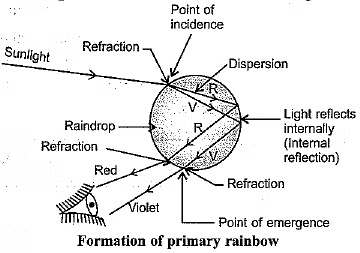
Therefore, due to refraction, dispersion and internal reflection of the sunlight, different colours reach the observer’s eye along different paths and become distinct. It creates a rainbow in the sky.
Hence “Rainbow is an example of dispersion of sunlight.”
Necessary conditions for the formation of a rainbow.
(i) The presence of water droplets in the atmosphere, and
(ii) The sun must be at the back of the observer, i.e. the observer must stand with his back towards the sun.
Q18: What is atmospheric refraction? Use this phenomenon to explain the following natural events.
(a) Twinkling of stars
(b) Advanced sunrise and delayed sunset.
Draw diagrams to illustrate your answers. (AI 2016)
 View Answer
View Answer 
Ans: Atmospheric Refraction: The refraction of light caused by the earth’s atmosphere due to gradual change in the refractive indices of its different layers by the varying conditions of it, is called atmospheric refraction.
(a) Twinkling of stars
The hot layers (low densities) of air at a high altitude, behave as an optically rarer medium for the light rays, whereas the cold dense layers (high densities) of air near the earth’s surface, behave as an optically denser medium for the light rays. So, when the light rays (starlight) pass through the various layers of the atmosphere, they will deviate and bend toward the normal. As a result, the apparent position of the star is slightly different from its actual position. Thus, the stars appear slightly higher (above) than their actual positions in the sky.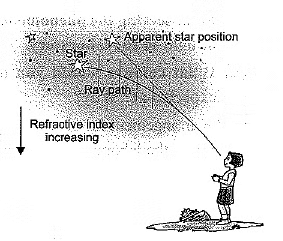 The fluctuation in the positions of the stars occurs continuously due to the changing amount of light entering the eye. The stars sometimes appear brighter and at some other times, they appear fainter. This causes the twinkling of stars.
The fluctuation in the positions of the stars occurs continuously due to the changing amount of light entering the eye. The stars sometimes appear brighter and at some other times, they appear fainter. This causes the twinkling of stars.
(b) Advanced sunrise and delayed sunset: The sun is visible 2 minutes before sunrise and 2 minutes after sunset because of atmospheric refraction. This can be explained below.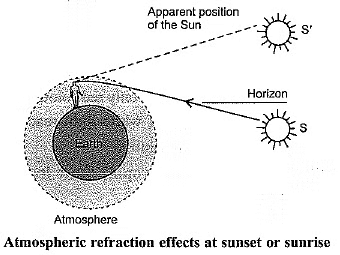
The figure shows the actual position of the sun S at the time of sunrise or sunset, just below the horizon while the apparent position S' above the horizon appears to us.
When the sun is slightly below the horizon, the light rays move through the different layers of varying refractive indices of air and get bent towards the normal. These rays appear to come from S' which is the apparent position of the sun. That is why, the sun is visible to us when it has been actually below the horizon or before the actual crossing of the horizon by the sun at the time of sunrise or sunset. So, due to the atmospheric refraction, the phenomenon of advanced advance sunrise and delayed sunset is observed.
Q19: In an experiment to trace the path of a ray of light through a triangular glass prism, a student would observe that the emergent ray:
(a) is parallel to the incident ray.
(b) is along the same direction of incident ray.
(c) gets deviated and bends towards the thinner part of the prism.
(d) gets deviated and bends towards the thicker part (base) of the prism. (CBSE 2016)
 View Answer
View Answer 
Ans: (d)
In a triangular glass prism, when a ray of light passes through, it first bends towards the normal upon entering the prism (due to refraction into a denser medium). As it exits the prism into a less dense medium (air), the emergent ray bends away from the normal. This causes the emergent ray to deviate from its original path, and it generally bends towards the thicker part (base) of the prism.
Thus, the correct answer is (d) gets deviated and bends towards the thicker part (base) of the prism.
Previous Year Questions 2015
Q1: What is a pupil? (CBSE 2005,2013,2015) View Answer
View Answer 
Ans: The pupil is a small circular transparent aperture whose size is controlled by the iris.
Q2: Name the condition resulting due to the eye lens becoming cloudy. (CBSE 2012,2013,2015)
 View Answer
View Answer 
Ans: Cataract
Q3: What is the dispersion of light? (CBSE 2012,2015)
 View Answer
View Answer 
Ans: Dispersion of light is the splitting of light into its component colours on passing through a dispersive medium e.g., a prism.
Q4: List the factors on which the scattering of light depends. (CBSE 2012,2015)
 View Answer
View Answer 
Ans: The scattering of light depends on the size of the scattering particle and the wavelength of light.
Previous Year Questions 2014
Q1: What is myopia? List two causes for the development of this defect. How can this defect be corrected using a lens? Draw ray diagrams to show the image formation in case of (i) defective eye and (ii) corrected eye.A student is unable to see the words written on the blackboard placed at a distance of approximately 4 m from him. Name the defect of vision the boy is suffering from. Explain the method of correcting this defect. Draw a ray diagram for the:
(i) defect of vision and also
(ii) for its correction.
What is myopia? State the two causes of myopia.
With the help of a labelled ray diagram show (a) the eye defect and (b) the correction of myopia. (DoE) (Foreign 2014)
 View Answer
View Answer 
Ans:
Myopia (Nearsightedness):
Myopia is a defect of vision in which a person can see nearby objects clearly but cannot see distant objects distinctly. The image of a distant object is formed in front of the retina instead of on it.
Causes:
- Excessive curvature of the eye lens.
- Elongation of the eyeball.
Correction:
- Concave lens (Diverging lens) is used to correct myopia.
- It diverges the incoming light rays so that the eye lens forms the image on the retina instead of in front of it.
Ray Diagrams:
(i) Defective Eye – Image of a distant object forms in front of the retina.
(ii) Corrected Eye – Concave lens diverges light rays, shifting the image onto the retina.
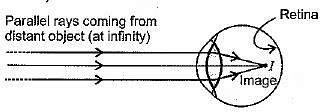
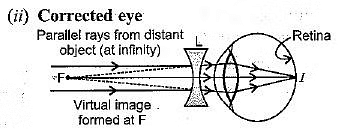
|
80 videos|662 docs|80 tests
|
FAQs on Class 10 Science Chapter 10 Previous Year Questions - The Human Eye and the Colourful World
| 1. What are the main parts of the human eye and their functions? |  |
| 2. How does the eye perceive colors? |  |
| 3. What is the role of the lens in the human eye? |  |
| 4. What is the significance of the blind spot in the human eye? |  |
| 5. How do refractive errors occur in the human eye? |  |

















